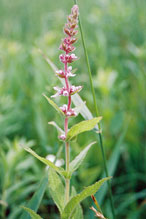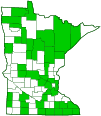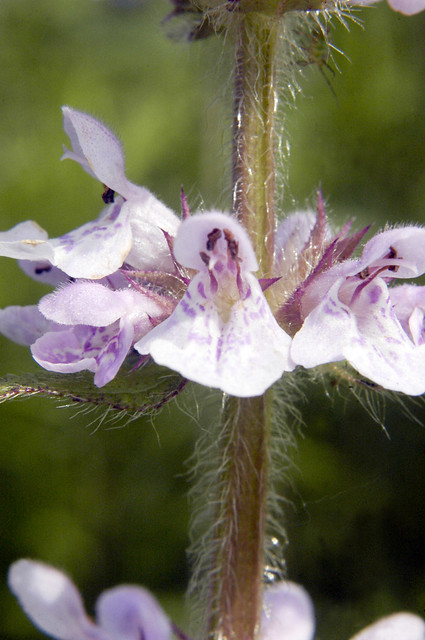woundwort
(Stachys pilosa var. arenicola)
Conservation • Wetland • Description • Habitat • Ecology • Use • Distribution • Taxonomy
Description |
Woundwort is a 12″ to 40″ tall, erect, perennial forb that rises from a rhizome. It often forms colonies. The stems are erect, square, hollow, and usually unbranched. They have copious hairs both on the ridges of the stem and between the ridges. The hairs on the ridges and those between the ridges are about alike and are somewhat bent downward. The leaves are opposite, narrowly oblong or linear oblong, 1⅜″ to 3½″ long, and ⅜″ to ¾″ wide, rarely wider. They are mostly stalkless but some may be on short leaf stalks. The leaf blades taper to a point at the tip and are broadly rounded or almost heart-shaped at the base. The upper surface is green and hairy. The lower surface is paler green and has hairs along the major veins. The margins have rounded, forward-pointing teeth. The inflorescence is a cluster of usually 6 flowers. Lower clusters rise from the upper leaf axils. Middle and upper clusters are opposite and are subtended by a small, leaf-like bract. Each pair of opposite flower clusters together form a false whorl. The bracts become gradually smaller as they ascend the stem. The flowers are 7 ⁄16″ to ⅝″ long. They have 5 green or purplish, hairy sepals that are fused at the base into a calyx tube ¼″ to ⅜″ long and separated at the end into 5 lance-shaped lobes. The calyx lobes are nearly as long as the calyx tube and are hairy. There are 5 petals that are fused at the base into a corolla tube about ¼″ long. The petals are pink or lavender with white spots. The calyx tube is always at least ⅔ as long as the corolla tube. The corolla is divided at the end into 2 lips. The upper lip is about 3 ⁄16″ long and ⅛″ wide, hood-like, hairy outside, hairless inside. The lower lip is divided at the tip into 3 lobes, a large central lobe and 2 smaller lateral lobes. There are 4 stamens protected beneath the hood. The fruit is 4 greenish-white, 3-ribbed, 1-seeded nutlets. They turn black when they ripen. |
Height |
12″ to 40″ |
Flower Color |
Pink or lavender with white spots |
Similar Species |
American germander (Teucrium canadense) flowers have a greatly reduced upper lip. Hairy hedge nettle (Stachys hispida) stems have hairs on the ridges but no hairs between the ridges. Marsh hedge nettle (Stachys palustris) stems have hairs on the ridges that are distinctly longer than those between the ridges. The leaves are wider, mostly ¾″ to 1½″ wide. Smooth hedge nettle (Stachys tenuifolia) stems have hairs on the ridges but no hairs between the ridges. The leaves may have hairs along the midribs but are otherwise hairless. |
Habitat |
Moist to wet. |
Ecology |
Flowering |
July to August |
Pests and Diseases |
|
Use |
|
Distribution |
||
|
Sources Biodiversity occurrence data published by: Minnesota Biodiversity Atlas (accessed through the Minnesota Biodiversity Atlas Portal, bellatlas.umn.edu, 6/20/2025). |
|
| 6/20/2025 | ||
Nativity |
||
Native |
||
Occurrence |
||
|
||
Taxonomy |
|
Kingdom |
|
Subkingdom |
Pteridobiotina |
Phylum |
Tracheophyta (Vascular Plants) |
Class |
|
Order |
Lamiales (Mints, Plantains, Olives, and Allies) |
Family |
Lamiaceae (Mint) |
Subfamily |
Lamioideae |
Tribe |
Stachydeae |
Genus |
Stachys (hedge nettles) |
Species |
|
Subordinate Taxa |
|
|
|
Synonyms |
|
Stachys arenicola Stachys brevidens Stachys palustris var.arenicola Stachys palustris ssp.arenicola |
|
Common Names |
|
hairy hedgenettle hairy hedge-nettle marsh betony marsh hedge-nettle prairie woundwort woundwort |
|
Glossary
Bract
Modified leaf at the base of a flower stalk, flower cluster, or inflorescence.
Calyx
The group of outer floral leaves (sepals) below the petals, occasionally forming a tube.
Corolla
A collective name for all of the petals of a flower.
Linear
Long, straight, and narrow, with more or less parallel sides, like a blade of grass.
Rhizome
A horizontal, usually underground stem. It serves as a reproductive structure, producing roots below and shoots above at the nodes.
Sepal
An outer floral leaf, usually green but sometimes colored, at the base of a flower.
Visitor Photos |
||
Share your photo of this plant. |
||
This button not working for you? |
||
|
||
|
||
MinnesotaSeasons.com Photos |
||
 |

Visitor Videos |
||
Share your video of this plant. |
||
This button not working for you? |
||
|
Other Videos |
||
|

Visitor Sightings |
||
Report a sighting of this plant. |
||
This button not working for you? |
||
|
|
MinnesotaSeasons.com Sightings |
||

|
Created: 8/20/2005 Last Updated: © MinnesotaSeasons.com. All rights reserved. |


